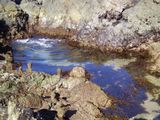Squirting by the pool
 There's quite a list of Australian Aboriginal words that are commonly used in Australian English, and some are known overseas: barramundi; boomerang; budgerigar; bunyip; corroboree; dingo; galah; kangaroo; koala; kookaburra and wallaby are just a few. It would be hard yakka to name them all.
There's quite a list of Australian Aboriginal words that are commonly used in Australian English, and some are known overseas: barramundi; boomerang; budgerigar; bunyip; corroboree; dingo; galah; kangaroo; koala; kookaburra and wallaby are just a few. It would be hard yakka to name them all.One such word is cunjevoi. When the Latins were here they named it Pyura stolonifera, but indigenous and other native-born Australians and others call it cunjevoi, or just plain cunji. The name comes from southern Queensland, and the animals are found along the east coast of Australia. Let's not be smug; Pyura stolonifera also squirts by pools in Chile and South Africa.
The indigenous people used to love the meat found within the tough 'tunic' of its starchy, fibrous stems, but repeatedly roasted and pounded the plant to remove a poison which can make your tongue and throat swell up, possibly fatally.
Fish don't seem to mind; they love cunji, so anglers love it too. These days, however, no self-respecting fisherman or -woman would wet a line using a piece of cunji on the hook. Not in view of the enlightened citizenry, that is.
The cunjevoi's a sea squirt, and my picture shows its habitat, around the edge of the low-tide mark on rocks where it sucks in the incoming water and spits out whatever isn't tucker, which tucker, to a cunji, is plankton. (Tucker, by the way, is a good Aussie word for food that has its origins in the German language, not one of the hundreds of Australian ones.) These cunjis can be seen sticking up from the rocks like chimneys by a pool in the rocks between home and Back Sandy. The cunji forms mats over the rocks and is usually covered in algae, giving it its characteristic green-brown colouring.
If you tread on one, it won't hurt you, and chances are you won't hurt it. You will, however, see something like a water pistol in action.
(Click thumbnail to enlarge)



















0 Comments:
Post a Comment
<< Home